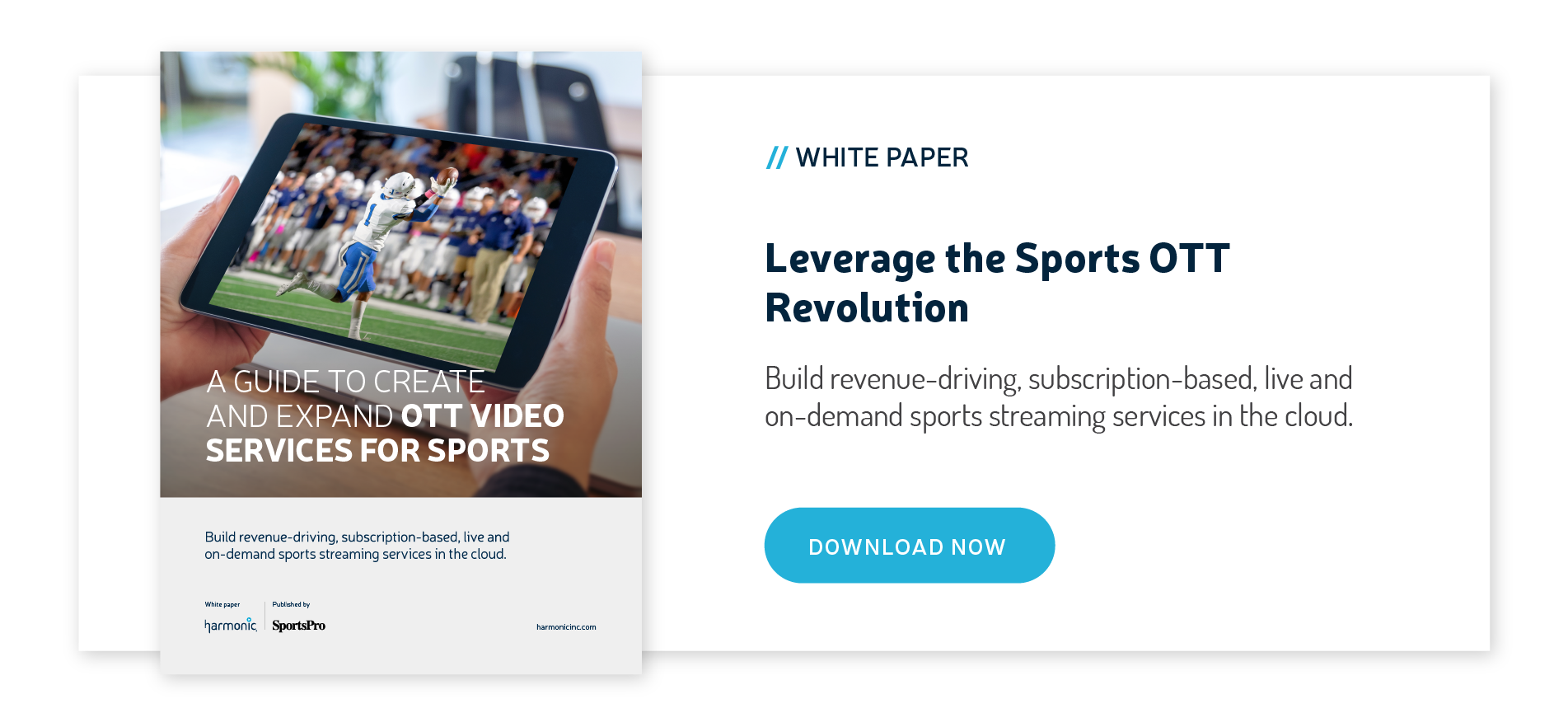OTT for sports is becoming increasingly attractive. There are growing investments in content acquisition that show how more and more companies are getting into the OTT game. According to a recent ReThink TV report, streaming will see sports media rights revenues hit $85 billion by 2024. Amongst the world's most lucrative sports, the price of soccer rights is expected to swell from $12.8 billion to $31.9 billion during this time period, primarily due to greater viewership of Europe’s top leagues in Asia and North America.
The revenue generated from subscriptions and advertisements is additional proof that interest is rising in OTT sports. The SportsPro OTT Summit in Madrid provided clear insights into the OTT sports streaming context, and we will share those takeaways with you here.
Video delivery using the internet is now revolutionizing the sports world
The internet has slowly been changing all aspects of our day-to-day lives, from work to entertainment, to learning and beyond. It took some time to get here, but now, the internet is revolutionizing how we interact with the world of sports.
The way that video content is delivered over the internet has created new business models and revenue opportunities. Video content delivered OTT is packaged differently than broadcast TV. Content, live streams, stats, VOD, and replay are available from a single application. OTT video delivery also provides access to a vast amount of user data. Analytics is playing a key role in driving sports video streaming forward. Compared with traditional broadcast, an OTT platform provider has access to a wealth of information about viewers and what they’re watching. This allows providers to better fine-tune their offering and provide subscribers with what they actually want to watch like we see today on Netflix, DAZN and Eleven Sports. Data also helps enable targeted advertising campaigns, which is already available on mature OTT platforms.
The revolution doesn’t stop there. OTT providers, some of which are pure-play sports operators like DAZN and Eleven Sports or digital channels such as the Tennis Channel, aim to deliver a more engaging experience. With OTT, they are able to offer new features, such as sports betting, directly into the application where content is consumed. And they can do it live. A good example is the Tennis Channel that is already planning to support this option.
The OTT sports landscape is expanding
The different offerings for OTT sports video delivery available today reflect the changing and growing market. It’s clear that the OTT viewing experience is appealing to more sports fans compared with the traditional broadcast experience. Does it mean that all sports content will have to be consumed differently? The answer is no. We see channels like DAZN diversifying with offers available on Xfinity STBs, and Eleven Sports has already been deployed by 12 pay-TV operators. Other operators are also working on similar agreements, a trend that is expected to continue over the next few years.
The real question: Is the OTT sports market sustainable?
To know the answer to that question, let’s look at the numbers. AMPERE showed in its presentation that in the Italian market, sports OTT D2C services were not profitable and that the distribution deal would make the difference by increasing viewership.
Will sports leagues kill the golden goose for traditional broadcast business models? Not yet. To start, sports leagues will use OTT delivery as a complement to broadcast delivery. And broadcasters also aim to enhance their traditional offering with new OTT services. These goals may change over time, as we have seen with more channels going D2C. LaLigua announced that OTT is only 8% of its revenue, but it expects that to rise to be around 20% by 2022 and up to 50% by 2025.
Assuming the broadcast growth is flat, this leads to a 43% CAGR progression. So for LaLigua, OTT is the real growth vector. And it wouldn’t be a surprise to see the company invest massively in OTT. Turner Sports’ coverage of March Madness provided similar numbers: a +8% increase in OTT audiences compared with 2018. In 2019, OTT represented 8% of the broadcast viewership, but 18% of the time viewed. That’s encouraging for Turner.
Cloud adoption is racing ahead
High-quality video delivery in the cloud has matured. One example of how the cloud was used for high-quality OTT live sports video delivery was the French Open in 2019, produced by France Televisions. All of the matches could be watched on iOS, Android and web (HTML5) ecosystems. Using the cloud was a natural choice to scale down video processing throughout the two-week tournament.
Social media is the next step for advertising and monetization
In order to drive the traffic on its applications, France TV Sports is using Wildmoka technology to extract and publish highlights in close-to-real-time conditions to social networks such as Twitter, Instagram, Facebook, YouTube, and Dailymotion. This boosts fan engagement but also demonstrates that social networks generated more than 50% of digital views. Digital viewership was higher than broadcast by 62% and grew year over year by 23%. France TV Sports apps were using sponsors, and we expect targeted advertisements to flourish in the future.
Personalization of the experience for consumers is key
Improvements in OTT technology enable video to be streamed in broadcast quality with low latency at scale. Thanks to powerful platforms like RDK and Android TV, even better experiences are on the horizon. These viewing experiences will be that much more exceptional on an operator set-top box.
Future video innovations show that real-world implementations are close at hand
For the first time, 5G was invited to the conference. Harmonic was thrilled to participate. Based on in-the-field experience gained when taking part in the first 8K streaming demonstration at the French Open tennis tournament last year, we know that high-quality, high-resolution OTT video delivered over 5G is possible.
The operators present (Vodafone and BT) were optimistic about 5G. It can offer a broad range of new services, which are currently being tested. These include multi-stream, multi-angle, augmented reality, virtual reality, and true HD. Harmonic is adamant that, especially as in the U.S., zero-rating is applied to OTT and we only get SD quality on unlimited plans. The hope with 5G is to be able to deliver HD (1080p60) at scale to all devices.
When we talk about scale, you have to think about a stadium where 100,000 fans are simultaneously trying to watch the replay of a goal. This has always been a dream for 4G and will one day become a reality for 5G. OTT is one technology that can be used to reach that goal, especially for the replay moments. However, 5G broadcast, also named FeMBMS (Future extended Multimedia Broadcast Multicast Service), could help to achieve high scalability for live use cases. 5G sports applications have already been deployed in Korea, Japan, and China. By the end of the year, it’s estimated that there will be more than 60 5G operator deployments (per Huawei’s count).
So what is the future outlook?
Sport is a vibrant market. Content owners are trying to optimize the monetization of their content using OTT delivery. There are now new pure-play sport OTT players in the field, like DAZN and Eleven Sports, that have very aggressive ambitions and are following in the footsteps of Netflix, which now dominates the delivery of premium entertainment content over the internet. These players have made progress thanks to their strong drive, their differentiation, and their consumer focus. But will they be profitable? That question remains unanswered.
Partnerships are going to be essential for success. OTT services will not be profitable without the support of operators marketing their offering. That scenario is a win-win situation for all parties. Netflix is distributed across more than 150 pay-TV operators, which brings significant revenue to Netflix, without the cost of acquiring those customers. We can expect similar schemes developed with pay-TV operators for sports content.
Is the broadcast model doomed? Not really, and Harmonic believes that broadcasters can add more interactivity to the fan experience on hybrid devices powered by Android TV. The proof was demonstrated at IBC with our technology partners Technicolor and 3SS.
On the infrastructure side, the cloud is still the best technology because it allows you to deploy fast, cope with the event-based nature of sports and create innovative services that can be consumed on any device. It is also the only viable economic model for tier-2 and tier-3 sports, where capital investments have to be minimal to test new markets. The next challenge for sports OTT, beyond the business model, is improving QoE. This will be the subject of an upcoming blog. Stay tuned!











